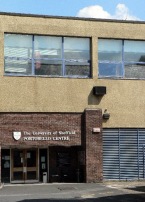We continue quoting definitions of what Human Language Technology (HLT) is, expressed by authorised scholars and institutions in order to gain a real insight into this interesting topic. In this second post, as we have previously published Hans Uszkoreit’s thesis, we are going to make a reference to an HLT definition by a renowned university.

The University of Sheffield (Portobello centre)
The definition that we are going to present today was given by the Natural Language Processing Group at the University of Sheffield (South Yorkshire, England), in whose head we find Yorick Wiks, another important and distinguished researcher in the field of computer science and artificial intelligence. They described Natural Language Processing as follows:
“Natural Language Processing (NLP) is both a modern computational technology and a method of investigating and evaluating claims about human language itself. Some prefer the term Computational Linguistics in order to capture this latter function, but NLP is a term that links back into the history of Artificial Intelligence (AI), the general study of cognitive function by computational processes, normally with an emphasis on the role of knowledge representations, that is to say the need for representations of our knowledge of the world in order to understand human language with computers.
Natural Language Processing (NLP) is the use of computers to process written and spoken language for some practical, useful, purpose: to translate languages, to get information from the web on text data banks so as to answer questions, to carry on conversations with machines, so as to get advice about, say, pensions and so on. These are only examples of major types of NLP, and there is also a huge range of lesser but interesting applications, e.g. getting a computer to decide if one newspaper story has been rewritten from another or not. NLP is not simply applications but the core technical methods and theories that the major tasks above divide up into, such as Machine Learning techniques, which is automating the construction and adaptation of machine dictionaries, modeling human agents’ beliefs and desires etc. This last is closer to Artificial Intelligence, and is an essential component of NLP if computers are to engage in realistic conversations: they must, like us, have an internal model of the humans they converse with.”
In conclusion, the Natural Language Processing Group at the University of Sheffield explains perfectly what NLP is about. Moreover, they explain it in a very simple way, using easily understandable examples to illustrate the concepts, and that is the reason why we have decided to include this definition in our project.
We hope that you have found these articles about Human Language Technology truly useful and we encourage you to carry on investigating about it. You will not regret.
References:
- NLP Group (2009). Natural Language Processing Group. University of Sheffield. Retrieved: 19:30, March 3, 2009, from
http://nlp.shef.ac.uk/ - Natural language processing. (2009, February 19). In Wikipedia, The Free Encyclopedia. Retrieved: 18:25, March 3, 2009, from
http://en.wikipedia.org/w/index.php?title=Natural_language_processing&oldid=110067975 - Yorick Wilks’ personal page (2009). In Natural Language Processing Group at the University of Sheffield. Retrieved: 19:36, March 3, 2009, from
http://www.dcs.shef.ac.uk/~yorick/ - Yorick Wilks. (2009, January 4). In Wikipedia, The Free Encyclopedia. Retrieved: 19:42, March 3, 2009, from
http://en.wikipedia.org/w/index.php?title=Yorick_Wilks&oldid=261889889
(Note: in the future this article could be modified several times in order to include more up-to-date information.)
